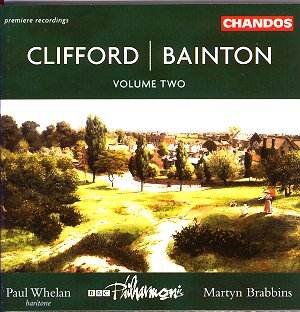Is it premature to remark on a pattern emerging in the more esoteric
reaches of the Chandos catalogue? Perhaps the two instances are isolated.
Anyway the pairing of Patrick Hadley and Philip Sainton on two orchestral
Chandos CDs can be compared with a brace of Edgar Bainton and Hubert
Clifford. Hadleyís vibrant pastoral choral/orchestral glories contrast
with Saintonís scorching Baxian tragedies (e.g. the tone poem The
Island). As for Bainton and Clifford, the former was a Brit who
emigrated to Australia while the latter was an Australian who came to
live in England. While Bainton wrote shoals of works before he departed
England and had his meed of performances in London and at the festivals,
Clifford had little produced in Australia and such reputation as he
secured was based on his concert and film music from the 1940s and 1950s.
Clifford wrote one thumpingly heroic symphony with wartime and filmic
resonances. Bainton wrote three with two coming from his Australian
years. Cliffordís symphony and Baintonís Second are paired on another
Chandos CD (CHAN 9757 also reviewed here a couple of years back). The
Third Symphony - a work of visionary epic strength awaits its first
digital recording. It will be a revelation to most people: tonal, aspiring,
romantic-impressionistic. It was recorded on the Australian BROLGA label
circa 1956 by the Sydney SO conducted by Sir Bernard Heinze (BZM12).
People should not rest until it and the Baintonís Concerto-Fantasia
(piano and orchestra) of 1929 have been recorded and issued.
The present disc is pleasing rather than outright compelling. The contrast
between then two composers is simplistically: Cliffordís splendid light
music and Baintonís Anglo-Impressionism. Bainton is thankfully represented
by two substantial works one of which is a superbly evocative essay
in sound and pastoral splendour. Thank heavens the Chandos repertoire
team avoided pairing Baintonís light music with Clifford lighter fare.
They could so easily have given us the Baintonís two rather inconsequential
orchestral suites written from pieces dating from Baintonís years at
the Rühleben internment camp circa 1916-18.
Baintonís Epithalamion (a song or poem in celebration
of a marriage) is a riotous fantasy in which the festivities and joys
mix Bacchus and Swinburne although in fact the inspiration comes from
Spenserís Elizabethan poem of the same name. Stylistically we are in
the same broad plain occupied by Ravelís Daphnis, Baxís Spring
Fire. It is a powerful work with an exultant long-limbed pastoral
melody at 6.10 brought to climactic culmination at 11.30 emblematic
of the pastoral school in full vibrancy and superbly communicated by
Yuri Torchinskyís solo violin at 11.35. Other parallels include Vaughan
Williamsí Norfolk Rhapsodies and Frank Bridgeís The Story of My Heart,
the scherzando second poem of the Two Jefferies Poems. As a form
the work seems to look towards late nineteenth century precedents such
as Rimskyís Sadko and Glazunovís The Sea and The Forest.
By comparison English Idyll is across its three Cardus
poems too mournfully musing in tone for much of the time. I am not sure
that Paul Whelan is not in some part accountable for this. He has one
of those grave sepia-toned voices - richer colouration might well have
helped. Naturally the piece has its strengths such as the rocking introduction
to the first movement part - idyllic in the manner of Vaughan Williamsí
music for the opera Sir John in Love and in the final song there
is a memorably sturdy and determined tread as in the Sea Symphony.
Then come the Clifford pieces. Clifford won the Cobbett prize for his
Kentish Suite. This was the prize for a suite suitable
for school orchestras. The Dover movement is baroque Sheban entry
made-over, Canterbury is familiar and fugal. The other movements
include the gentlest pastoral touches (similar to RVWís Dives and
Lazarus), a scherzo-tarantella in which Falstaffís dissolute band
seem to burst out of the orchestral fabric and the shades of an Elgarian
march in the shape of Greenwich Pageant. Casanova Melody
written for the film of The Third Man (the one in which
Anton Karasís cimbalom hauntingly created the Harry Lime theme)
was written under a pseudonym. It is suitably hyper-romantic with music
use made of harp and solo violin. Five English Nursery Tunes
includes a zinging surreptitiously sinister tarantella, a reverential
evening prayer for solo viola, a chuckling and dancing Lavender Blue,
the downy-light Curly Locks and the effervescent London Bridge.
Finally Shanagolden portrays the place in Eire where Cliffordís
grandmother died in 1922. He had visited the place in 1953 so it was
vivid in his memory when he wrote the piece. It is rather in the manner
of other short sunlit pastoral idylls: C.W. Orrís Cotswold Hill-Tune
or Max Saundersí Cotswold Pastoral. It is a yearning aureate
piece.
We must implore Chandos to continue this series and next time include
the Bainton Third Symphony and Concerto-Fantasia perhaps with
some brief film music pieces by Clifford.
This disc is superbly documented (as you would expect with Lewis Foreman)
with meticulous attention to detail and sensitively designed. Strongly
recommended especially for Epithalamion and Shanagolden.
Everything here is pleasing. Much of the Clifford music is undemanding
lighter fare.
Rob Barnett
Strongly recommended especially for Epithalamion and Shanagolden.
Ö see Full Review

